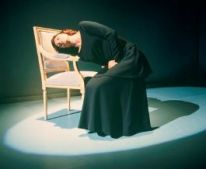REVIEW OF “ROOM,” THEATRICAL ADAPTATION OF VIRGINIA WOOLF
Review of Room
Editor’s Note: Patricia Laurence, Woolf scholar and professor of English at Brooklyn College, the City University of New York, attended the March 16 performance of Room and wrote this review.

Imagine a string of pearls–“moments of being”–from Woolf’s A Room of One’s Own and A Sketch of the Past strung together in a dramatic adaptation. This is the experience of attending Room, an admirable production mounted by the New York Women’s Project, under the direction of Ann Bogart, and adapted from Woolf’s works by Jocelyn Clarke.
These “moments” are a part of Woolf’s philosophy that a great part of our everyday life is lived as “non-being,” or what she calls the “cotton wool” of ordinary experience. But “one’s life is not confined to one’s body and what one says and does,” asserts Woolf, and behind “the cotton wool” of the every day is a hidden pattern. This pattern is revealed in exceptional and infrequent “illuminations, matches struck in the dark,” moments of being.
It is these moments that are revisited in Room a praiseworthy effort to bring Virginia Woolf’s words and advice about writing and reading to broader audiences–though the night I attended, the words were addressed to, mostly, a room of women.
Though imaginatively choreographed by Ellen Lauren and Ann Bogart—at times, almost a dance of the body to accompany the dance of Woolf’s mind–this production misses the mark. In transforming Woolf’s writing into a drama, it ignores her philosophy and her own pattern of narration—that moments of being are embedded in the ordinary cotton wool of experience and, therefore, shine all the brighter when they occur.
In this production, moments and polemics combine and are too densely packed to have their effect. Where, one wonders, is the cotton wool, the ordinary stuff of life, to buffer and frame these moments in the experience of the theatergoer? This is not just Woolf’s philosophy but also a principle of drama.
The production begins with Virginia Woolf among us: “Good Evening,” says the cool voice of Ellen Lauren, as she makes her way down the aisle to the stage, tall and lean as Woolf. She asks us to “Imagine a room, your own….” and the stage for the next ninety minutes becomes that material and inner room of the mind so important to women and fiction. It is a room with a closed door that invites women to write.
Originally A Room of One’s Own was a lecture delivered to the women of Newnham and Girton Colleges, Cambridge University, in 1928– the year full equal voting rights would be extended to women in England—and then published in written form, 1929. Given the times, Woolf is always self-conscious about tone as she weaves her arguments against the exclusion of women from education, jobs and the material conditions necessary to the writing of fiction. Sensitive always to how the male audience would “hear” and be persuaded by her lecture—Woolf works by stealth and indirection in arguing and avoids stridency of tone. At times, in Bogart’s production this tone is violated, absorbing didacticism and assertiveness from another time and place.
Nevertheless, we listen attentively to the flight of Woolf’s mind, and her reflections on “what is meant by reality”; how the writer has “a shock-receiving capacity”; the “moments of being” of appreciating a flower “that is the whole” or experiencing revulsion at violence. And, importantly, in portraying Woolf in this production, how memoirs too often are failures because they say, “this is what happened” but “they leave out the person to whom things happened.” In finale, it is asserted that “you cannot write without a room of your own,” and money, a material condition that Woolf would have added to this production.
There were some wonderful moments in this evening where Ellen Lauren captured the rapture and the waves in the synchrony of Woolf’s words and her body. What is intriguing is that the actress, and Ann Bogart, the director and founder of the SITI theater company with Tadashi Suzuki, studied photographs of Woolf and created a lexicon of physical structures, what they term “a sort of alphabet.”
As the words of Woolf unfolded during the presentation, there was a physical score, so that at one moment, we observe Lauren bent sideward over a chair, magically not touching it, and projecting a stillness of mind. At another time, she dances the rapture of Woolf’s words. It is this–the choreography of words, mind and body that speaks to a new kind of acting and direction in Woolf productions (and, hopefully, productions that will involve astute Woolf critics and scholars in the process).
For those living in NYC, there are two more days–through Sunday, March 27—to see this production.
Comments